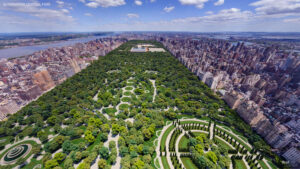Central Park, the green spirit of New York City, stands as a testament to the vision and genius of its creators. It provides a peaceful escape from the hustle and bustle of city life spread throughout Manhattan. This popular park is a focal point for urban planning, not just a place to relax and escape; In the concrete jungle, a striking symbol of New York City’s commitment to preserving nature.
Did you know that Central Park, for all its beauty and grandeur, was America’s first landscaped public park? This piece of history only begins to scratch the surface of Central Park’s grandeur. Join us as we delve into discovering the true size of this urban oasis, revealing not only its height but the facts and figures that make Central Park truly amazing.
1: Historical perspective
The beginning of Central Park
A green gem, Central Park lies in the heart of New York City. Its history is rich, its purpose two-fold. Serving as a peaceful refuge for urbanites seeking solace and a vibrant place full of life and fun, Central Park is no surprise Its immaculate design dates back to the 19th century, and it addresses the growing need for green space in rapidly urbanizing Manhattan. A landmark year in New York City history was 1857, when the park opened its doors to the public, a breath of fresh air in a wave of industrial progress.
Design and Construction
The marvel that today stretches in the middle of Manhattan Island didn’t just happen; it was meticulously crafted. Spearheading the design was America’s foremost landscape architect Frederick Law Olmsted and accomplished English architect Calvert Vaux. The pair, fueled by a visionary spark and an unwavering resolve, embarked on an ambitious project christened the “Greensward Plan”.
Unleashing modern landscaping techniques and intricate design elements, they transformed an inhospitable landscape of rocky terrains and swamps into a picturesque oasis sprinkled with enchanting vistas, serene lakes, and winding trails. Aspiring to create an arena that encouraged social interaction and immersion in nature, Olmsted and Vaux faced myriad challenges, not the least of which was the displacement of Manhattan’s rugged geology.
Powered by an army of over 20,000 workers, the park construction was a colossal endeavor that spanned more than a decade. In an era devoid of machines and modern construction technology, worker toiled day and night, blasting through rock and moving earth, to shape Central Park into what Olmsted and Vaux envisaged.
2: Central Park by the Numbers
Central Park, an emblematic feature of New York City, is renowned not just for its beauty and the oasis of calm it offers but also for its impressive dimensions.
Official Measurements
Length: Central Park spans 2.5 miles (or approximately 4 kilometers) from north to south.
Width: At its widest point, the park stretches 0.5 miles (or about 800 meters) from east to west.
Total Area: The park covers a sprawling 843 acres (or roughly 341 hectares).
Comparison with Other City Landmarks
When placed beside other famous urban parks worldwide, Central Park’s imposing size becomes even more apparent.
- Hyde Park, London: Central Park dwarfs London’s Hyde Park, which covers 350 acres—less than half the size of Central Park.
- Luxembourg Gardens, Paris: Even more petite when compared, the famed Luxembourg Gardens in Paris span merely 60 acres.
- Ueno Park, Tokyo: Central Park also surpasses Tokyo’s popular Ueno Park, which encompasses about 133 acres.
3: Understanding scale
Visual and practical comparisons can be illuminating in understanding the size of Central Park. Let’s dig into the details next.
Central Park overlooking Manhattan Island
A unique feature of New York City is its unusual grid design, especially in Manhattan, where Central Park is located. Central Park, which spans most of the midtown area of Manhattan, is a unique, striking and green contrast to the urban grid.
The park stretches from 59th Street to 110th Street, encompassing the length of 51 city blocks. From a geographic perspective, it stretches from Fifth Avenue to Central Park West, disturbing the typical density of the Manhattan grid system in broad areas To put this in perspective, you can think of the park as green it is also a large square that regularly plagues the inner city.
Length in the runtime
A favorite activity for many park-goers is walking the length of Central Park. But how long does it take to get from the north end of the park to the south end?
The average walking speed is around 3 to 4 miles per hour, but this can vary greatly depending on a person’s fitness, age and legs. With this in mind:
- At a leisurely pace of 2 miles per hour, it will take about 1.25 hours.
- At a speed of 5.5 miles per hour, you can complete the walk in just over 42 minutes.
However, these figures do not take into account the potential stops or routes to get around and access the many attractions scattered throughout the park. From the breathtaking Bethesda Terrace Fountain, to the spectacular Bow Bridge, to the Alice in Wonderland statue, there is plenty to see and do throughout your trip.
4: Central Park Today
Presently, Central Park stands not just as a place of green respite amidst the concrete landscape, but also as a prominent cultural and social hub in the heart of New York City.
The Park’s Role in New York City Life
Central Park plays a multifaceted role in the lives of New Yorkers and visitors alike.
For many locals, the park serves as their go-to place for exercise, social gatherings, or merely a tranquil area to enjoy nature’s tranquility amidst the city’s incessant activity. Tourists, on the other hand, view the park as an iconic symbol of New York City, a must-visit destination complete with history, charm, and diverse attractions.
An excerpt from the New York Times encapsulates this sentiment perfectly: “Central Park is the grand, green heart of New York City. It is an oasis of nature in the middle of a bustling city, a place for rest and relaxation, and a hub of cultural and recreational activities.”
Attractions Spread Across Its Length
The vast length of Central Park is generously studded with numerous popular attractions that enthrall visitors and locals alike. Some highlights include:
- The Central Park Zoo (Mid-Park at 64th Street): Home to a variety of species from around the world, the zoo is a hotspot for animal lovers of all ages.
- Strawberry Fields (West Side between 71st and 74th Streets): A serene memorial to John Lennon of the Beatles, attracting fans worldwide.
- Bethesda Terrace and Fountain (Mid-Park at 72nd Street): Renowned for its beautiful architecture and spectacular views of the lake.
- Belvedere Castle (Mid-Park at 79th Street): With its fairytale-like structure and vista of the park, it’s a popular site for visitors.
- The Great Lawn (Mid-Park from 79th to 85th Street): One of Central Park’s most iconic spots, the Great Lawn is a perfect place for picnics and outdoor games.
5: Conservation and Challenges
Because Central Park stands as a beacon of natural beauty and tranquility in the heart of bustling New York City, continued conservation efforts and strategies are important In urban development and the environment in addition to meeting problems, the park faces many challenges.
The future of Central Park
Looking ahead, Central Park has plans for future growth and revitalization that strike a careful balance between growth and conservation.
- Improvement or revitalization programs: These focus on improving visitors and expanding the educational offerings of the park, without compromising its size and integrity.
- Responding to climate change: Plans have been developed to make the park more resilient to climate change, such as improving drainage to combat excessive rainfall and strengthening beaches and prevented the earth from being destroyed.
6: Look at the length of Central Park
Stretching nearly 2.5 miles (4 km) from north to south, the vast expanse of Central Park offers a variety of experiences This stunning urban oasis in the heart of New York City invites exploration in areas that beautiful, historic sites and activities
Ways to visit the park
There are many ways to see the length of Central Park, each offering a different perspective on its beauty and grandeur. Whether you enjoy a leisurely walk, a quick bike ride, or a guided tour, the park caters to everyone’s tastes.
- Walking: Walking in the park allows for gentle exploration, perfect for stopping at famous landmarks, having a picnic, or just taking in the sights.
- Bikes: Bikes are perfect for covering a lot of ground quickly, and bike rental facilities and dedicated trails make up for it.
- Guided Tours: For those interested in Central Park’s history and environment, guided tours offer an insightful account of the park’s design, features and notable stories.
Guest comments and reviews
People from all walks of life have visited Central Park, each taking away a different story. Here are small certificates highlighting personal experiences along the length of the park:
- New Yorker Emma: “Walking the entire length of Central Park is my favorite way to disconnect. Every time feels different, depending on the season or time of day.”
- John, a visitor: “We rented bikes to cover a lot of ground and were amazed at how big the park really is. It was amazing to see the difference from one end to the other.”
- History enthusiast Samantha: “Taking part in the guided tour opened my eyes to the park’s rich past. It’s interesting to learn what went on to make it the place it is.” the design of such a mark.”
7: Effect of size of Central Park
The significance of Central Park’s size is undeniable. Its size, approximately 2.5 miles long and 0.5 miles wide, contributes significantly to the ecological balance, economic vitality and cultural richness of New York City
Economic and environmental considerations
As one of the most visited urban parks in the world, Central Park provides a significant economic boost to New York City.
- Tourism: Attracting millions of visitors each year, the park contributes significantly to the local economy through spending on accommodation, food, entertainment and transportation.
- Property values: Residences near the park have higher property values, which means higher real estate revenues and tax revenues.
At the same time, Central Park, as a green bubble in the middle of a concrete jungle, offers many environmental benefits.
- Clean Air: Park trees and plants filter air pollutants, improving the overall air quality of the city.
- Biodiversity: The expansive green space is home to a variety of birds, insects and mammals, and promotes biodiversity.
- Temperature control: By providing shade and evaporating hot water, the garden helps to moderate temperatures, an effect known as urban cooling
conclusion
Understanding the length of Central Park leads to a greater appreciation of its central role in New York City. Its size makes it a center of economic activity, an ecological reserve and a cultural centre.
As we think about Central Park, it’s important to consider the magnitude of its impact. Indeed, would New York City be the same without the iconic Green Heart? Central Park highlights how urban parks can dramatically shape the life and character of a city through their impressive size and thoughtful management.


